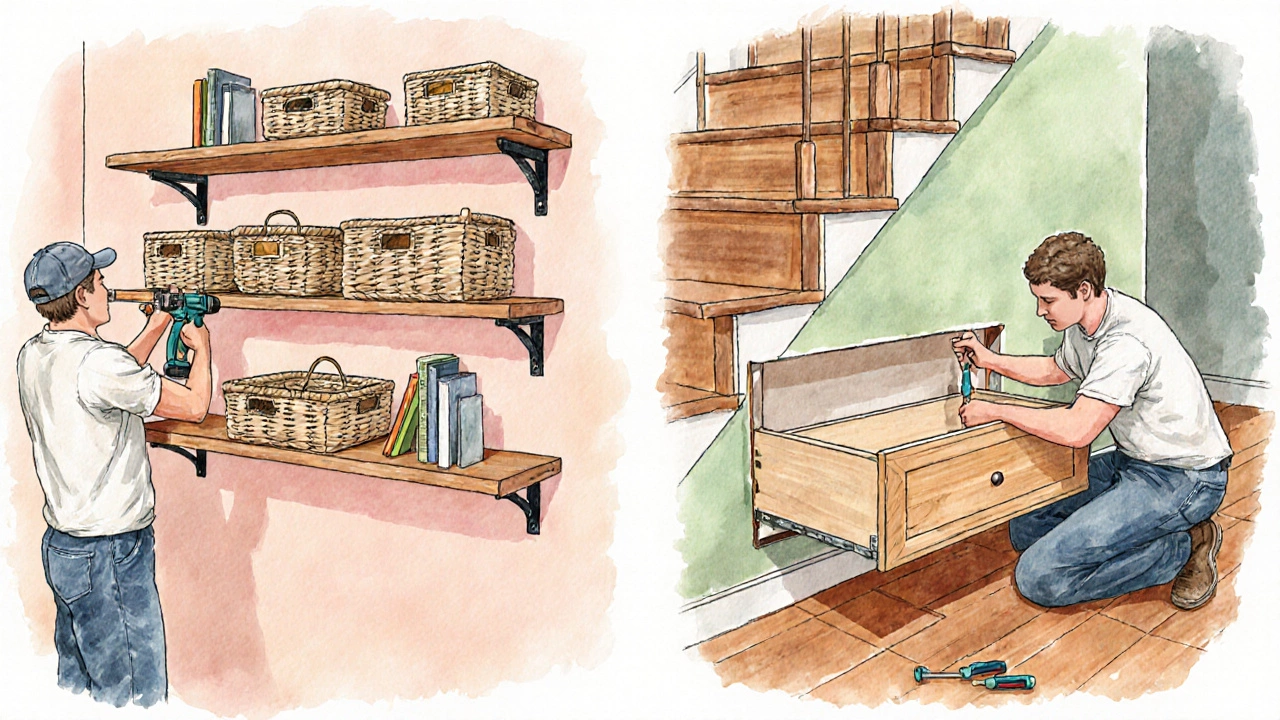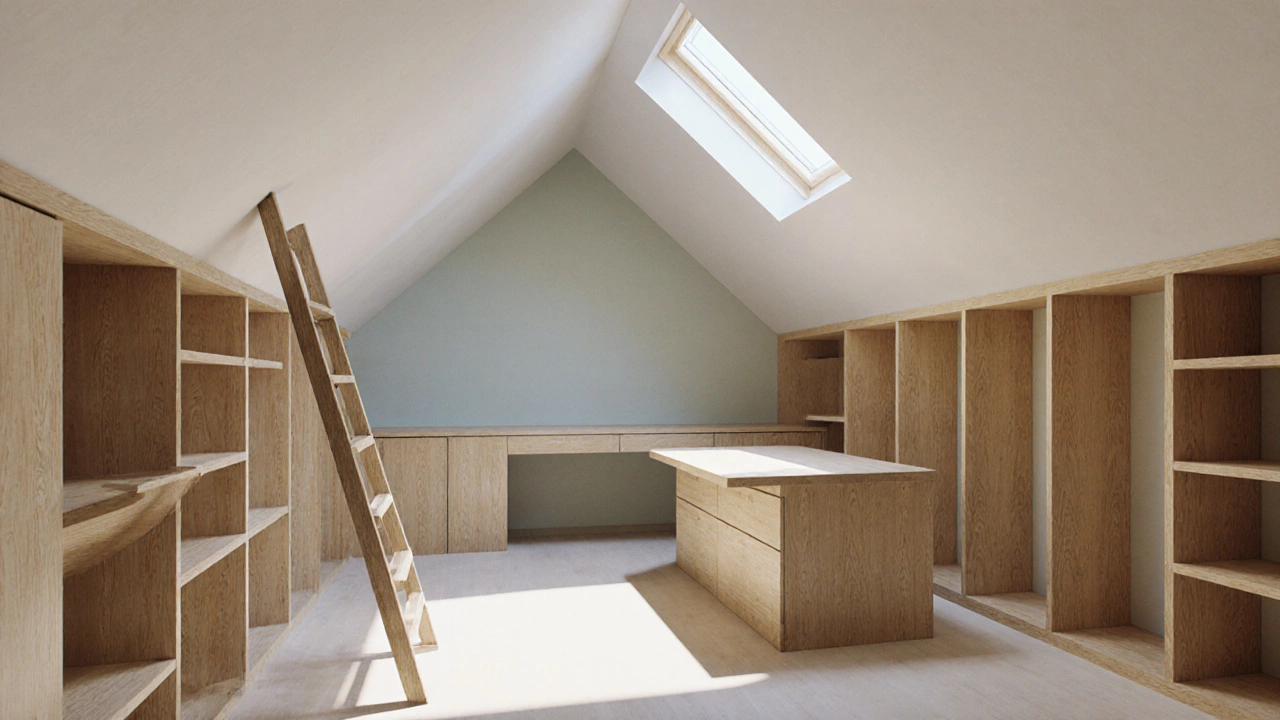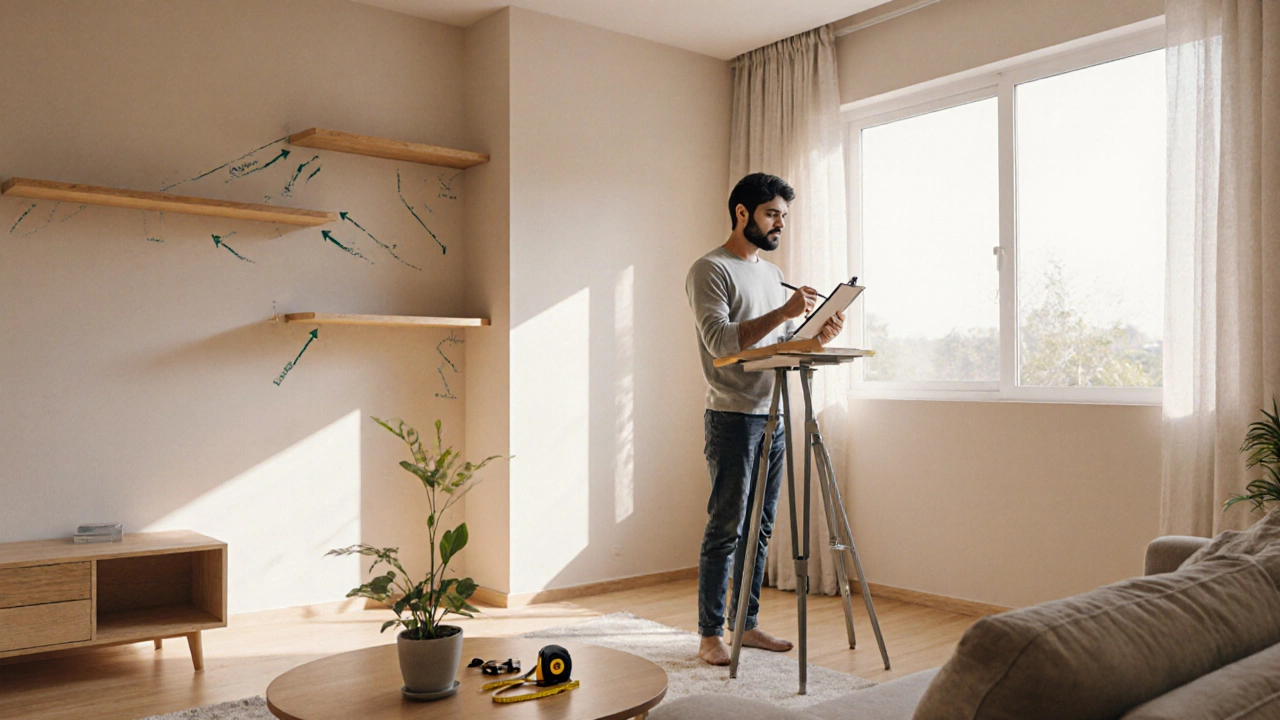When space feels tight, extra storage is the game‑changer that lets you reclaim clutter‑free living.
Start With a Quick Space Audit
Before you swing a hammer or order a custom cabinet, take five minutes to note where you lose square footage. Grab a pen and walk through each room, asking:
- What items do I use daily vs. rarely?
- Which walls or corners sit empty?
- Do I have unused vertical space?
- Are there areas like under the stairs or behind doors that could hold more?
Jot these down in a simple table - this becomes your extra storage roadmap.
DIY Solutions You Can Tackle This Weekend
Most homeowners can boost capacity without calling a contractor. Below are proven ideas, each with a short step‑by‑step guide.
1. Install Floating Shelves
Floating shelves turn blank walls into display and stash zones. They’re perfect for books, plants, or decorative boxes.
- Measure the wall length and mark stud locations.
- Drill pilot holes, insert wall anchors if needed.
- Secure the mounting brackets, then slide the shelf onto them.
- Style with uniform baskets for a clean look.
2. Create Under‑Stair Nooks
Most stairs have wasted space under the tread. A custom-built drawer or open cubby can hold shoes, cleaning supplies, or hobby gear.
- Sketch the dimensions, accounting for the slope.
- Cut plywood to fit, adding a front panel for a seamless look.
- Install hinges or sliders, then paint to match surrounding trim.
3. Choose Multi‑Functional Furniture
Ottomans with hidden compartments or a coffee table that lifts to a desk give you two functions in one footprint.
- Shop for pieces that list interior dimensions for the hidden space.
- Consider a sofa with built‑in side shelves for magazines and remote controls.
4. Upgrade Closet Organizers
Even a modest closet can store more with the right system.
- Install a double‑rod for shirts and pants.
- Add a shelf above the rod for bins or seasonal items.
- Fit pull‑out baskets on the floor for shoes.
5. Add Garage Wall Shelving
Garages often become catch‑alls. Heavy‑duty steel shelves keep tools, paint cans, and sports gear off the floor.
- Anchor brackets into studs for safety.
- Use clear plastic bins with labels to maintain order.
When a Bigger Project Makes Sense
If your audit shows that the bottleneck is the lack of whole‑room space, consider one of these larger renovations.
Attic Conversion
Turning the attic into a bedroom, office, or storage loft adds dozens of square feet.
- Check local building codes - you’ll need proper egress, insulation, and ventilation.
- Install a stairway or ladder that meets safety standards.
- Finish walls with drywall, then add shelving or built‑in closets.
Basement Finishing
A finished basement can serve as a media room, gym, or massive storage area.
- Seal any moisture issues first - a wet basement defeats any storage plan.
- Frame walls, run electrical, and add vapor‑proof drywall.
- Include overhead racks and low‑profile shelving for bulky items.
Garage Conversion
When you no longer need a vehicle spot, convert the garage into a workshop, guest suite, or full‑blown storage annex.
- Assess load‑bearing walls - you may need an engineer’s sign‑off.
- Add insulation and windows for livable comfort.
- Install heavy‑duty cabinetry that can handle tools and seasonal gear.

DIY vs. Professional: Quick Comparison
| Criterion | DIY (Weekend) | Professional (Months) |
|---|---|---|
| Cost | Low - materials only ($200‑$1,500) | Higher - labor + permits ($5,000‑$30,000+) |
| Time Commitment | 1‑3 weekends | 2‑6 weeks |
| Skill Level | Basic carpentry, measuring | Licensed contractors, engineers |
| Permits Needed | Usually none for small shelves | Often required for structural changes |
| Value Boost | Modest (organization appeal) | Significant (extra square footage) |
Pro Tips & Common Pitfalls
- Measure twice, cut once. A mis‑cut shelf can waste both material and space.
- Leave at least 2‑inch clearance in walkways to avoid a cramped feel.
- Use the same finish (paint or stain) across built‑in units for a cohesive look.
- Label every bin, basket, or drawer - the best storage fails without a system.
- Don’t overload wall anchors; check weight ratings and distribute load across studs.

Quick Checklist Before You Start
- Complete a room‑by‑room audit.
- Decide between DIY fixes and larger remodels.
- Set a realistic budget and timeline.
- Gather tools: drill, level, stud finder, measuring tape.
- Purchase matching hardware and finishes.
- Follow local building codes for any structural changes.
Frequently Asked Questions
Can I add storage without compromising room aesthetics?
Yes. Choose built‑in styles that match existing trim, use hidden compartments like under‑stair drawers, and keep hardware finishes consistent. Floating shelves painted the same color as the wall blend in while still providing function.
Do I need permits for a small attic conversion?
Most municipalities require a permit when you add habitable space, which includes proper egress, insulation, and electrical work. Check your city’s building department; a simple storage loft may be exempt, but safety rules still apply.
What’s the best material for garage shelving?
Heavy‑duty steel with a powder‑coat finish resists rust and holds up under weight. Pair it with clear, stackable plastic bins for visibility.
How can I keep my new storage organized long‑term?
Adopt the “one‑in, one‑out” rule, label every container, and schedule a quarterly purge. A simple inventory spreadsheet can remind you where each item lives.
Is it worth hiring a contractor for a basement finish?
If you have moisture issues, need structural walls, or plan to add plumbing, a professional ensures code compliance and protects your investment. For simple shelving, DIY is fine.

